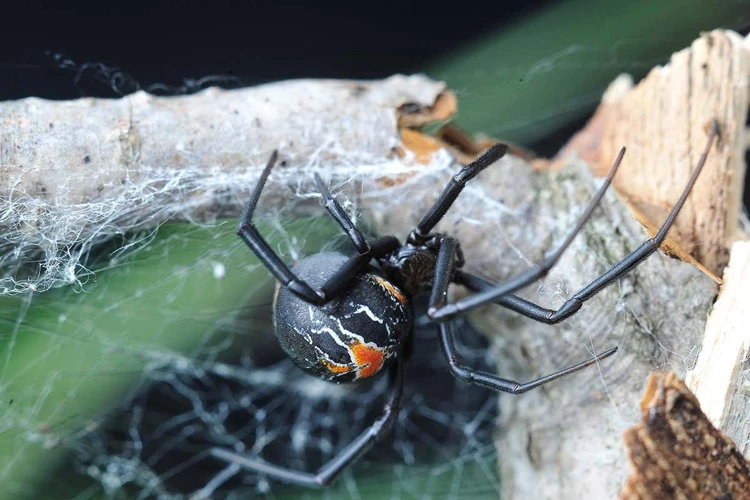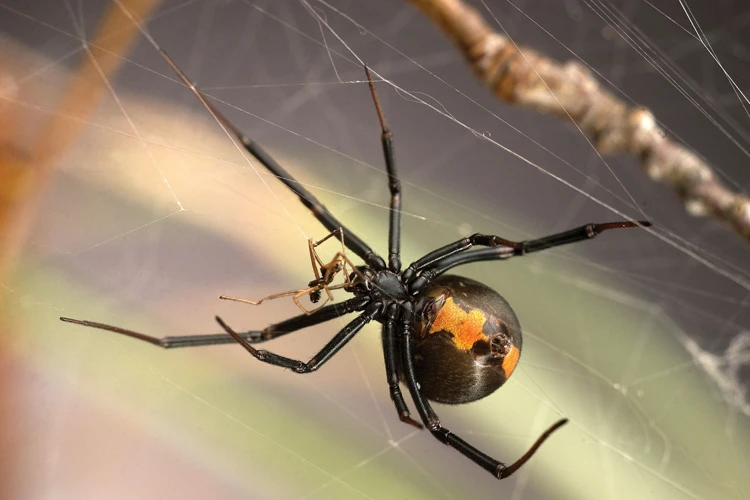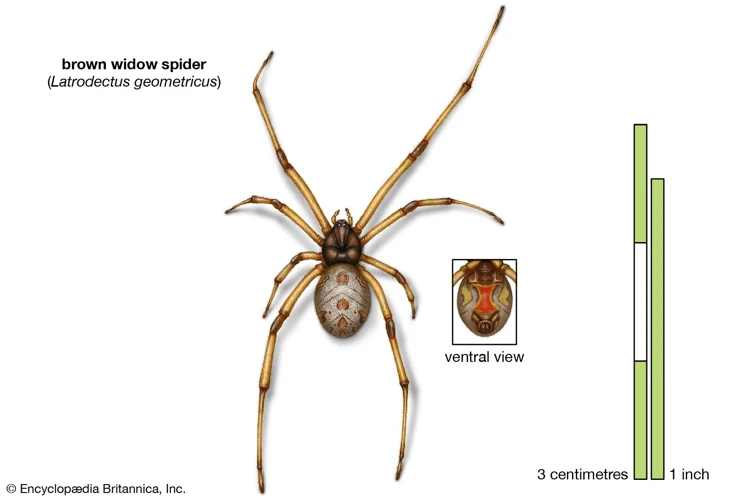As we delve into the world of arachnids, one can’t help but come across the mysterious and captivating Black Widow spider. Known for their venomous bite, the Black Widow spider boasts some fascinating reproductive traits that set it apart from other spiders. In this article, we’ll explore the intricate process of sperm storage in female Black Widows and its role in egg fertilization. From the nitty-gritty of the sperm web and spermathecae to the dangers these spiders pose to humans, we’ll take a step-by-step journey into the fascinating world of these creatures. So, let’s spin a web of knowledge and uncover the wonders of female Black Widow spider reproduction.
Background

The Background of Black Widow Spider Reproduction
Black widow spiders have long fascinated scientists with their unique reproductive biology. As one of the most venomous spider species in the world, black widows are known for their distinctive black color and red hourglass marking on their abdomen. However, their reproductive abilities are equally intriguing. Female black widows possess the ability to store sperm for long periods of time, allowing them to fertilize their eggs months after mating. This article will delve into the process of sperm storage in female black widows and how it facilitates egg fertilization and development. We will also explore the role of sperm storage in the evolution of black widow spiders and the dangers they pose to humans. For more information on black widow spider eggs and development, check out this article.
Black Widow Spider Reproduction
Black widow spiders are members of the family Theridiidae and are well-known for their dangerous venomous bite and the distinctive red hourglass marking on their abdomen. They are also highly notorious for their unique reproductive habits. The black widow spider reproduction is sexual in nature and involves males depositing sperm into the female’s spermathecae during mating.
Mating in black widow spiders is not without risks. Female black widows are known for their cannibalistic approach to their male counterparts after mating. In fact, males of some species have evolved a behavior known as “thanatosis” or playing dead during mating to avoid being attacked by the female.
Once the male black widow spider succeeds in mating with a female, he deposits his sperm into the female’s reproductive tract. The female’s internal reproductive organs are located in the cephalothorax, the front part of the spider’s body.
Female black widows can store sperm from a single mating event for an extended period of time and use it to fertilize multiple egg sacs. This is possible because the female’s spermathecae can store sperm for up to two years.
The fertilized eggs then develop in the female’s abdomen, forming a sac. A female black widow spider may lay up to nine egg sacs in a single reproductive season, with each sac containing between 100-400 eggs. The eggs hatch into spiderlings after a gestation period of 10-30 days, depending on the species.
To learn more about the development and care of black widow spider eggs, see our article on maternal care in black widow spiders.
Sperm Storage in Female Black Widows
Female Black Widow spiders are well known for their red hourglass marking on their abdomen and venomous bite. However, reproductive biology of these spiders is also fascinating. The female Black Widow spider stores the sperm of the male in her body for an extended period of time, sometimes up to a year, until she is ready to fertilize her eggs.
Sperm Web and Spermathecae: During mating, male Black Widow spiders transfer sperm to the female through the use of their pedipalps. The female has two spermathecae, which are sac-like structures located in her abdomen. The male deposits his sperm into the female’s initial chamber of the two spermathecae. Next, the female creates a “sperm web” in her abdomen by producing a substance that hardens and encases the sperm.
Fertilization Process: When the female is ready to lay eggs, she moves the sperm from the sperm web into the second chamber of her spermathecae to be used to fertilize the eggs. The female Black Widow can lay between 200 and 900 eggs, with an average of 400 eggs, in an egg sac which she attaches to webs, debris, or vegetation. It takes around a month for the eggs to hatch, and the spiderlings will emerge from the egg sac to disperse a few days later.
Egg Laying and Development: Egg laying and development of the Black Widow spider is a complex process. Several factors such as temperature, humidity, and prey availability could affect this process. The female invests a significant amount of time and energy to produce and care for her offspring. Proper egg sac placement has been observed to be vital in the survival of spiderlings.
Black Widow females are one of the few spiders that exhibit parental care towards their offspring. Females invest greatly in the offspring, protecting the egg sac and guarding against predators. The parental investment that the female Black Widow provides to her offspring could account for her need for long-term sperm storage.
The sperm storage and usage of female Black Widow spiders play a significant role in their reproductive success and survival. This evolution in reproductive behavior ensures that the female spiders are able to ensure their offspring’s survival while having maximum reproductive output. To learn more about black widow spider eggs and the egg sac count, visit our website /black-widow-egg-sac-count/.
Female Black Widow Sperm Storage

The female black widow spider has a unique and fascinating ability to store sperm from multiple mating sessions, which can be used for offspring fertilization at a later time. This process is vital to the reproductive success of the black widow spider species and has evolved over millions of years. In this section, we will explore the specifics of female black widow sperm storage and the essential role it plays in the spider’s reproductive process. Additionally, we will touch upon the topics of fertilization, egg-laying, and development, which are closely linked to the sperm storage process. For more information about black widow spider reproductive biology, check out our articles on /sex-determination-black-widow-spider-eggs/, /egg-sac-placement-black-widow-spiders/, /parental-investment-black-widow-eggs/, /black-widow-eggs-hatch-duration/, /black-widow-egg-sacs/, /black-widow-egg-stage-compare/, and /factors-egg-dev-black-widow/.
Sperm Web and Spermathecae
When mating with male black widow spiders, a female stores the sperm in two different places, namely in a special structure called a spermatheca, and on a web called a sperm web. The female digests the sperm from the web and stores only the motile sperm in the spermathecae, which are two small sacs located near the ovaries. The spermathecae, filled with gelatinous material, preserve the sperm and protect them from external agents such as bacteria.
It is noteworthy that black widows produce a special type of silk, called cribellate silk, to create the sperm web. The web is an essential attribute for the storage of sperm in female black widows as it allows for the storage of sperm, preserves the motility of the sperm for successful fertilization, and functions as a physical barrier that prevents the sperm from escaping.
The process of sperm storage in black widow spiders is carefully regulated. When the male inserts his palpal bulbs into the female genital opening, he releases a mixture of sperm and a substance that causes the female to stop eating the male and instead mate with him. With the use of their pedipalps, male spiders transfer sperm to the female, who then creates the sperm web. The female carefully wraps the web with her palps, manipulating it to create small droplets of gel, in which the sperm is embedded.
Through this detailed and complex process, black widow spiders have evolved an efficient way of storing sperm, which allows them to lay multiple egg sacs over an extended period. The spermathecae can store sperm for up to two years, ensuring that the female has enough sperm to fertilize all of her eggs, even if no males are present. This adaptation provides female black widows with the ability to reproduce successfully, even in the absence of live males.
Fertilization Process
The fertilization process in female Black Widow spiders is quite unique and fascinating. After a male spider deposits his sperm onto a web, a female spider can then collect the sperm with her epigynum, a genital structure on her abdomen.
Once collected, the sperm is stored in the spermathecae, two small sacs located near the female spider’s reproductive organs. The spermathecae are specially adapted to store sperm for long periods of time, ensuring fertilization can occur when the female lays her eggs.
When the female is ready to fertilize her eggs, the sperm is released from the spermathecae and travels through a narrow duct to be used for fertilization. This process can occur multiple times, with the female using the stored sperm for numerous egg-laying events.
It is worth noting that not all of the sperm stored in the spermathecae may be used for fertilization. Research has shown that females may selectively use sperm from specific males, potentially in a way to ensure the healthiest offspring. This behavior is referred to as sperm competition.
The fertilization process in Black Widow spiders involves an intricate interplay between the male and female spiders, with the female’s ability to store sperm playing a crucial role in the success of the species.
Egg Laying and Development
After fertilization, the female black widow spider will lay her fertilized eggs. The number of eggs laid depends on the species but can range from 100 to over 400. The eggs are contained within a silken sac, which the female attaches to a surface inside her web.
The development of the eggs from laying to hatching can take several weeks or even months, depending on the environmental factors such as temperature and humidity. During this time, the female spider will carefully guard and protect her eggs against predators and environmental threats.
Table
To better understand the egg development process in black widow spiders, here is a table summarizing the key stages:
| Stage of Egg Development | Description |
|---|---|
| Egg Laying | Female attaches silken sac containing eggs to a surface within her web |
| Egg Development | Embryo undergoes cell division, and crucial organ development takes place |
| Incubation | Eggs are kept warm, usually by the female guarding them |
| Hatching | Young spiders emerge from the egg sac |
As you can see from the table, egg development is a multi-stage process that involves many important steps. A disruption in any of these stages can lead to reduced viability or death of the developing embryos.
While it may seem straightforward, egg laying and development in black widow spiders is a complex process that requires careful attention from the female spider. The survival of the spider’s offspring depends on her ability to protect and nurture them through each stage of development.
Role of Sperm Storage in Black Widow Spider Evolution

The process of sperm storage in female black widow spiders has played a significant role in the evolution of this species. The ability of female black widows to store sperm for extended periods, up to several months, has allowed them to increase their chances of successful reproduction in challenging environments.
One of the advantages of sperm storage is that it enables female black widows to mate with multiple males without the need for multiple copulations. This increases genetic diversity in the offspring, leading to stronger and more adaptable offspring. Additionally, females can store sperm from larger, stronger males for future fertilization, increasing the likelihood of producing successful offspring.
Another important role of sperm storage is that it has allowed the black widow spider to adapt to harsh environments. In environments where males are scarce or mating opportunities are infrequent, the ability to store sperm for extended periods helps ensure fertilization when the opportunity arises.
Over time, the process of sperm storage has coevolved with the male mating behavior of black widow spiders. Male spiders have developed longer copulatory organs that allow them to transfer more sperm, in turn increasing the chances of successful fertilization.
The ability of female black widows to store sperm has played a crucial role in the evolution of this species. It has provided adaptations that enable them to reproduce more efficiently and successfully, ensuring the continuation of the species.
Dangers of Black Widow Spiders for Humans
It’s no secret that black widow spiders are infamous for their toxic bites which can be dangerous to humans. The venom of a female black widow spider is considered to be one of the most powerful in the world, with potentially deadly consequences.
The venom contains neurotoxins that are capable of attacking the nervous system and causing severe pain and muscle cramps. In most cases, the bite of a black widow spider does not result in serious injury, but it can cause complications, especially in individuals with weakened immune systems, such as the elderly, children, and those with pre-existing medical conditions.
Symptoms of a black widow spider bite may include intense pain, muscle cramps and stiffness, nausea, vomiting, abdominal pain, and difficulty breathing. In severe cases, a black widow spider bite can cause seizures, paralysis, and even death.
It is crucial to seek medical attention immediately if you suspect that you or someone you know has been bitten by a black widow spider. Antivenom is available to counteract the effects of the venom, but it must be administered as quickly as possible after a bite occurs.
The best way to prevent black widow spider bites is to take precautions when working outside, especially in areas where these spiders are known to inhabit. Wearing protective clothing such as gloves and boots, and shaking out any clothing or equipment before use can help reduce the chances of encountering a black widow spider. Additionally, it’s important to keep your home and outdoor spaces clean and organized, as black widow spiders are attracted to cluttered environments.
While black widow spiders play a vital role in the ecosystem, they can pose a significant danger to humans. It’s important to take precautions to avoid encounters with these spiders and seek medical attention immediately if a bite occurs. Remember, prevention is the key when it comes to black widow spider bites.
Conclusion
After exploring the world of sperm storage in female black widow spiders, it is clear that this process plays a crucial role in the reproductive success of these arachnids. The female black widow spider’s ability to store sperm for extended periods is a remarkable adaptation that enables them to reproduce multiple times, even with a single male. Furthermore, the spermathecae and sperm web facilitate optimal sperm storage and fertilization of the eggs, resulting in successful reproduction.
Black widow spiders, while fascinating in their reproductive capabilities, are also a real danger to humans. Their venom can cause severe symptoms, ranging from muscle aches and spasms to breathing difficulties and even death, particularly among the young and elderly. Therefore, caution is essential when coming into contact with these spiders, particularly in areas where they are commonly found.
In summary, the ability of female black widows to store sperm for several months or even years ensures the continuation of their species. While this adaptation is remarkable, it is essential to remember that black widow spiders are venomous and pose a danger to humans. Therefore, it is necessary to take precautions when in proximity to them.
Frequently Asked Questions
How long can female black widow spiders store sperm?
Female black widow spiders can store sperm for up to 150 days.
How many spermathecae do female black widow spiders have?
Female black widow spiders have two paired spermathecae in their reproductive system.
Can female black widow spiders mate multiple times?
Yes, female black widow spiders can mate multiple times and store the sperm in their spermathecae for future fertilizations.
How long do black widow spider eggs take to hatch?
Black widow spider eggs take around 20-30 days to hatch.
Do male black widow spiders contribute to parental care?
No, male black widow spiders do not contribute to parental care and typically die shortly after mating.
How many eggs can a female black widow spider lay?
A female black widow spider can lay up to 400 eggs in one or multiple egg sacs.
Can black widow spiders survive in cold environments?
No, black widow spiders tend to prefer warm environments and cannot survive in extremely cold temperatures.
Are black widow spider bites lethal to humans?
While black widow spider bites can be serious and cause symptoms such as muscle pain and cramps, they are rarely lethal to humans.
Do male black widow spiders pose a danger to humans?
No, male black widow spiders do not possess venomous bites and are not a danger to humans.
What is the evolutionary advantage of sperm storage in female black widow spiders?
The ability to store sperm allows female black widow spiders to ensure fertilization even if a suitable mate is not immediately available, leading to increased reproductive success.






